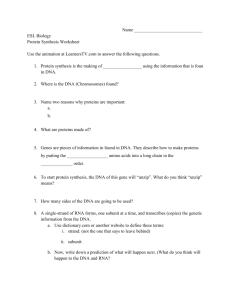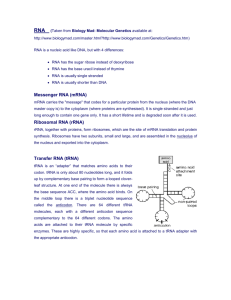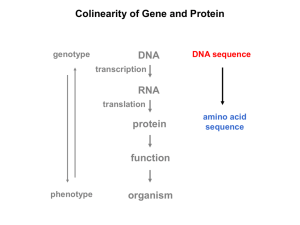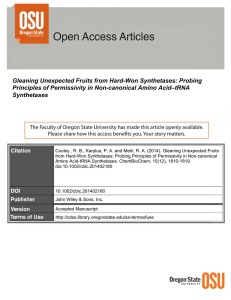02/10
advertisement
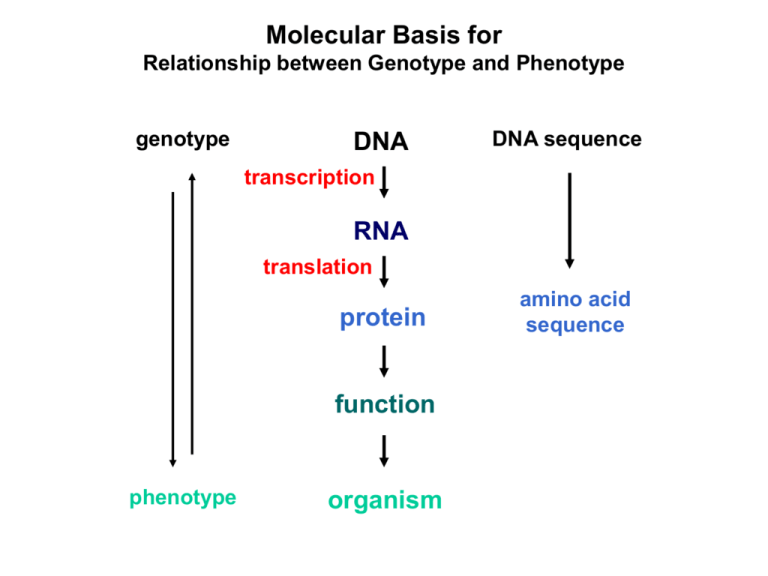
Molecular Basis for Relationship between Genotype and Phenotype genotype DNA DNA sequence transcription RNA translation protein function phenotype organism amino acid sequence Intron Splicing: Conserved Sequences exons - coding sequences introns - noncoding sequences Small nuclear ribonucleoprotein particles (snRNPs) recognize consensus splice junction sequence of GU/AG. snRNPs are complexes of protein and small nuclear RNA (snRNA). Several snRNPs comprise a spliceosome. Spliceosome directs the removal of introns and joining of exons. Spliceosome Assembly and Function Spliceosome interacts with CTD and attaches to pre-mRNA. snRNAs in spliceosomes direct alignment of the splice sites. One end of conserved sequence attaches to conserved adenine in the intron. The “lariat” is released and adjacent exons are joined. Reactions in Exon Splicing Self-Splicing Reaction RNA molecules can act somewhat like enzymes (ribozymes). In the protozoan Tetrahymena, the primary transcript of an rRNA can excise a 413-nucleotide intron from itself. These self-splicing introns are an example of RNA that can catalyze a reaction. Transfer of Information in Prokaryotes and Eukaryotes What are the similarities? What are the differences? Colinearity of Gene and Protein genotype DNA DNA sequence transcription RNA translation protein function phenotype organism amino acid sequence Colinearity of Gene and Protein “The linear sequence of nucleotides in a gene determines the linear sequence of amino acids in a protein.” Mutant alleles of trpA gene differed in the position of the mutation at the DNA level, which corresponded to position of amino acid substitution in the gene product. Colinearity of mutations and altered amino acids in a subunit of tryptophan synthetase from E. coli C. Yanofsky, 1967. Scientific American Tryptophan Synthetase Activity indole-3-glycerol phosphate a subunit glyceraldehyde 3-phosphate indole serine subunit tryptophan Molecular Basis for Relationship between Genotype and Phenotype genotype DNA DNA sequence transcription RNA translation protein function phenotype organism amino acid sequence tRNA Anticodon of a tRNA molecule recognizes and pairs with an mRNA codon. tRNA contains modified bases: pseudouridine, methylguanosine, dimethylguanosine, methylinosine, dihydrouridine. Genetic Code Aminoacyl-tRNA Synthetase Attaches Amino Acid to tRNA Aminoacyl-tRNA synthetase catalyzes the formation of “charged” tRNA. There is an aminoacyltRNA synthetase for each amino acid. The carboxyl end of an amino acid is attached to the 3’ end of the tRNA. Wobble Position Some tRNA molecules can recognize and pair with more than one specific codon. Base-pairing between the 3’ base of a codon and 5’ base of an anticodon is not always exact.





